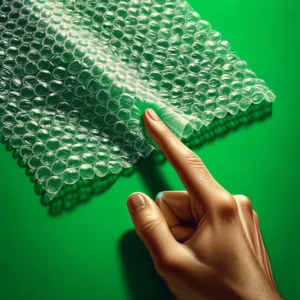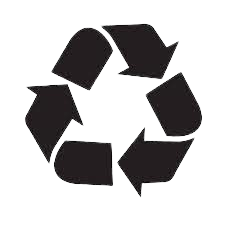Is Bubble Wrap Recyclable?

Recycling plays a pivotal role in modern waste management and is instrumental in driving the agenda of environmental conservation. By converting waste materials into new products, recycling reduces the consumption of fresh raw materials, decreases energy usage, minimizes air and water pollution, and lowers greenhouse gas emissions.
The importance of recycling extends across various dimensions of environmental sustainability and resource efficiency. By embracing recycling, society can protect natural resources, conserve energy, reduce pollution, and promote a healthier, more sustainable planet for future generations.
Bubble wrap is an impact preventive solution to secure fragile goods and give cushioning during delivery. The packaging is a light plastic substance accessible in various sizes, shades, and thicknesses. In this article, we will share more about bubble wraps and whether they are recyclable.
What is Bubble Wrap?
 Bubble wrap, made of flexible bubbles, is an inflatable cushioning material supplied in various sizes to protect delicate items during transportation and storage. The packaging has a bubble structure, usually made from two plastic sheets with air pockets. Filling the bubbles with air or a novel gas mixture helps absorb shock, vibration and pressure.
Bubble wrap, made of flexible bubbles, is an inflatable cushioning material supplied in various sizes to protect delicate items during transportation and storage. The packaging has a bubble structure, usually made from two plastic sheets with air pockets. Filling the bubbles with air or a novel gas mixture helps absorb shock, vibration and pressure.
Bubble packaging is mainly made from polyethene, PVC, copolymer resins and non-PVC formulations. They come in several forms, such as rolls for wrapping, sheets for making die-cut blisters, bags for packing multiple objects and pouches for delicate items. Find out more about bubble wrap air pillows, which can help occupy less storage space.
Uses of Bubble Wrap
Bubble wrap is used as a void filler for cushioning protection, and there are different uses for this packaging solution. The protective packaging is waterproof and airtight and protects against dust and moisture.
- Protect items during shipping, especially fragile items such as glassware, electronics, and artwork. The air-filled bubbles provide cushioning and help to absorb shock during transit.
- Protect items during storage, especially items that are prone to damage from moisture, dust, or other environmental factors. The air-filled bubbles provide a protective layer that helps to prevent scratches, dings, and other forms of damage.
- Used as a form of insulation to help keep buildings or vehicles warm or cool. The air-filled bubbles provide a layer of insulation that helps to trap heat or cold air, depending on the desired effect.
Types of Bubble Wrap
Different types of bubble wrap include metallised foil bubble wrap, kraft paper bubble roll, foam-backed bubble roll and self-adhesive bubble wrap with anti-static properties.
- The standard bubble is the most common type, featuring small air-filled bubbles that cushion fragile items during shipping and storage.
- The large bubble has bigger air-filled bubbles, providing more cushioning and protection for larger, heavier items.
- Anti-static bubble prevents static electricity from building up, making it ideal for packaging electronics or other sensitive equipment susceptible to static discharge damage.
- Biodegradable bubble breaks down over time, reducing their environmental impact.
- Coloured wraps for decorative or branding purposes.
- Bubble wrap that has perforations between the bubbles, allowing it to be easily torn into smaller sections for packaging smaller items or custom-sized packages.
How to Recycle Bubble Wrap
Bubble wrap is essential for product protection and packing and can be recycled. Here are some tips on how to recycle bubble wrap:
- Separate bubble wrap from other packaging materials like OPP tapes and foam peanuts.
- Each area is different depending on local regulations and laws. Look for local drop-off centres that accept bubble wrap for recycling. Find store packaging centres and hauliers that take specific types of plastic packaging for recycling.
- Check for companies that participate in takeback programs or other programs that enable the reuse and upcycling of bubble wrap.
- Reuse the bubble wrap again until its lifespan is exhausted. Use it to wrap items such as books or antiques before storing or shipping them.
Always remember that cleanliness is required for recycling. Plastic containers should be washed and dried before throwing them out. Bubble wrap labels and residue should also be removed. Some facilities may not accept bubble wrap due to contamination. To find out, research more on policies in the area or contact the municipality’s waste management office.
Alternatives to Bubble Wrap
There are environmentally friendly alternative void-fill packaging solutions. Let’s examine a few alternative packaging solutions. 
To reduce bubble wrap use, explore alternative packaging materials such as cardboard boxes, paper void fillers or biodegradable packing peanuts. For additional protection, use carton liners or corrugated cardboard. Cardboard offers the same protection as plastic and is easier to recycle and compost. A paper crumpler or packing paper can cushion during shipping or moving and be used for fragile items. The material has minimal residues and is easy to dispose of. Reusable fabric, such as quilt batting and cotton pillowcases, can be used instead of plastic airbags for cushioning.
Consider the size, shape, and weight when choosing a void-fill packaging solution. Some solutions have thicker walls for protection but might not fit around fragile objects. Choose something that meets the packaging requirements to ensure product security against impact during transportation.
Tips for Reducing Bubble Wrap Use
Bubble wrap is a common packaging material used to protect goods when shipping. Goods shipped worldwide are increasing, and finding a packaging solution that safeguards goods and decreases carbon footprint is vital—selecting eco-friendly packaging materials and cutting down plastic packaging. Below are some methods to reduce bubble wrap use.
- Look for biodegradable packaging products and compostable materials from sustainable forests, such as corrugated cardboard or natural kraft paper.
- Pick materials made of recycled content with high post-consumer content. This decreases natural production resources and encourages users to recycle the product.
- Instead of plastic bags, use paper or other textile fibre bags to ship small cushion items without needing single-use plastics.
- Consider air pockets from mylar or biodegradable cornstarch instead of plastics. Cushion products and reduce the reliance on plastics.
Let’s all do our part to save the environment and move towards sustainable packaging trends that will change the industry. At Stream Peak, we provide an extensive array of void-fill packaging solutions, encompassing both bubble wrap and air pillows for shipping. Our expertise extends to consulting on your packaging needs and enhancement strategies. Don’t hesitate to contact us for a no-obligation consultation, where our packaging engineers can visit your operations site to collaborate on optimal solutions.
Frequently Asked Questions
Q: Is bubble wrap recyclable?
A: Yes, bubble wrap is recyclable in Singapore. If you are overseas, check with the local recycling centre to see if they accept bubble wrap.
Q: How should I prepare bubble wrap for recycling?
A: Before recycling bubble wrap, flatten it out and remove any excess air. Remove any other materials, such as tape, labels, or plastic packaging, that may be attached to the bubble wrap.
Q: What can bubble wrap be recycled into?
A: Bubble wrap can be recycled into various items such as insulation, cushioning for furniture, and shipping materials.

